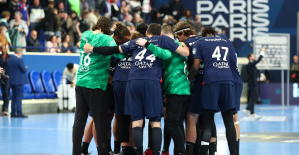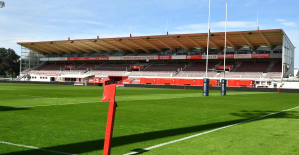Mario Frese's farm is a romantic's dream. Cows with black and white spots lie on a bed of straw in the open and spacious barn or chew the self-grown and GMO-free feed at the feeding stand, little calves stretch their heads out of their boxes to be petted and play in the large half-timbered barn next door Cats between the farm machines.
Nevertheless, the idyllic dairy farm in the village of Mörshausen in northern Hesse is a catastrophe for the climate. After months of analysis, the Nürtingen-Geislingen University of Applied Sciences (HfWU) calculated that the farm emits 1.07 kilograms of CO₂ equivalents per kilogram of fresh milk produced. And Frese's 130 cows produce around 1.2 million kilos of raw milk a year. According to the scientists, the bottom line is that almost 1400 tons of CO₂ are generated.
But that is about to change radically. Nestlé Germany wants to ensure this together with the HfWU and the dairy cooperative Hochwald. The three partners selected the dairy farmer Frese's farm for the "Climate Dairy Farm" model project.
The aim of the initiative is to reduce the CO₂ footprint of the farm as much as possible, if possible even mathematically to zero. For this purpose, the work on the more than 300-year-old farm is to be analyzed and optimized over a period of three years - and then serve as a blueprint for other farmers.
The background is the sustainability efforts of Nestlé Germany. By 2050 at the latest, the manufacturer of brands such as Maggi, Thomy, Wagner Pizza, Garden Gourmet, Kitkat, Smarties and Nespresso wants to be climate-neutral in Germany. But that only works if Nestlé's suppliers massively improve their carbon footprint.
According to the company, 80 percent of emissions alone can be traced back to the raw materials used. By far the largest item is milk and its derivatives such as whey, lactose or skimmed milk powder. "Milk causes the most greenhouse gases in our supply chain," says Corinna Weinmiller, Sustainability Manager at Nestlé Germany. "We want and need to change that."
Bauer Frese is also part of this chain. Every other day, tankers collect the raw milk from Hochwald and bring it to the dairy's cheese factory in Hünfeld, 60 kilometers away. Among other things, mozzarella is made there, which then ends up on the frozen ready-to-eat pizzas from Nestlé's Wagner brand.
In order to reduce the CO₂ footprint of these pizzas, Frese is now changing his farm work in some areas, including feeding the cows, growing the feed, manure management and energy production. Food additives to prevent methane burping Take feed as an example: "If cows are fed the best possible feed, they can use it better and produce more milk - which ultimately reduces emissions per kilogram of milk," explains Stephan Schneider, Professor of Animal Nutrition at the HfWU. Using a feed analysis plan, he determined the optimal composition of grass and maize silage, grain, rapeseed meal and molasses for Freses animals.
For this purpose, so-called silage additives are added to the feed, which make it easier to digest, reports Schneider. The addition of a new additive from a Dutch company is also being considered, with which the formation of climate-damaging methane gas in the cow is disrupted and massively reduced. Each animal exhales an average of around 300 liters per day.
But the changes go far beyond the composition of the feed: a so-called push-on robot ensures that the animals always have an even amount of feed available. Usually the cows push the feed away with their snouts in search of the best parts. The robot now moves it back up to eight times a day.
CO₂ can also be saved with liquid manure. Urine and faeces currently flow out of the barn together on Freses farm and end up in an open liquid manure tank. It is to be covered in the future and supplemented by a biogas plant. In addition, different drains for urine and faeces are planned, because the enzyme urease contained in the faeces splits the urea into ammonia and carbon dioxide, which pollutes the atmosphere.
Despite the various measures, the emissions cannot be completely reduced. "What remains should be compensated for by natural carbon storage in fields and fields," explains Markus Frank, Professor of Plant Health Management at the HfWU. This means: In future, farmer Frese will plant hedges and copses in the areas of his 220 hectares of land that are difficult to manage and will also plant flower strips. This allows additional CO₂ to be stored from the air.
In addition, on several hectares, he replaces classic pasture grass with clover, peas and lupins, which draw nitrogen from the air. "This reduces the consumption of artificial fertilizer," explains Frank. Aerial photos from satellites should show how the plants are doing and where in the fields more or less fertilizer is needed. "More targeted fertilization means less fertilization," explains Frank.
Mineral fertilizer is one of the biggest drivers of CO₂ emissions because of the high energy consumption during production. “All the measures are not rocket science and not science fiction. But if they are implemented, and ideally all at the same time, they can have a great impact.” Exactly how much is documented and analyzed in the Climate Dairy Farm project.
To this end, the project partners are investing a six-figure amount in measurement technology, a vehicle scale, the push-on robot and the additional resources on the Frese farm, among other things. And that's just one measuring point for Nestlé. The group is currently rolling out the climate dairy farm concept worldwide. In the first step, 45 such projects are planned, 20 of which already exist, primarily in South America and Asia.
In Germany, the farm in northern Hesse is the first, but more are to follow. "We are currently seeing a shortage and increasing price of food due to the Ukraine war and the Corona crisis. But that is only a gentle foreshadowing of what is still in store for us as a result of climate change," says Marc Boersch, Nestlé's head of Germany. "That's why we have to act now and establish new standards now."
Hochwald also wants to see to that. "The climate dairy farm complements and supports our own climate goals," says Managing Director Detlef Latka. "Other farmers should also benefit from what we learn here." It is no coincidence that a medium-sized farm was chosen as a model. “This is an average and therefore representative farm. A lot of other people can identify with that,” explains Latka.
In fact, you have to. Because in the medium term, customers would no longer be able to buy the milk if dairies and their affiliated dairy farmers do not comply with certain climate criteria. "We will put pressure on our suppliers in the future," announces Boersch. "There will be a selection." Without CO₂ reduction measures, a long-term cooperation with Nestlé is no longer conceivable.
Boersch can also imagine making the climate commitment visible on the product packaging in the future, for example in the form of an environmental symbol or a sustainability traffic light analogous to the Nutri-Score. And preferably at European level, as the manager emphasizes.
The fact that Nestlé wants to be a pioneer is not a question of philanthropy. "We have a certain size and therefore have to lead the way," says Boersch. In addition, shareholders and investors are increasingly paying attention to the commitment of companies to nature and the environment. "And we want to continue to exist."
"Everything on shares" is the daily stock exchange shot from the WELT business editorial team. Every morning from 7 a.m. with our financial journalists. For stock market experts and beginners. Subscribe to the podcast on Spotify, Apple Podcast, Amazon Music and Deezer. Or directly via RSS feed.

 United States: divided on the question of presidential immunity, the Supreme Court offers respite to Trump
United States: divided on the question of presidential immunity, the Supreme Court offers respite to Trump Maurizio Molinari: “the Scurati affair, a European injury”
Maurizio Molinari: “the Scurati affair, a European injury” Hamas-Israel war: US begins construction of pier in Gaza
Hamas-Israel war: US begins construction of pier in Gaza Israel prepares to attack Rafah
Israel prepares to attack Rafah Spain is the country in the European Union with the most overqualified workers for their jobs
Spain is the country in the European Union with the most overqualified workers for their jobs Parvovirus alert, the “fifth disease” of children which has already caused the death of five babies in 2024
Parvovirus alert, the “fifth disease” of children which has already caused the death of five babies in 2024 Colorectal cancer: what to watch out for in those under 50
Colorectal cancer: what to watch out for in those under 50 H5N1 virus: traces detected in pasteurized milk in the United States
H5N1 virus: traces detected in pasteurized milk in the United States Private clinics announce a strike with “total suspension” of their activities, including emergencies, from June 3 to 5
Private clinics announce a strike with “total suspension” of their activities, including emergencies, from June 3 to 5 The Lagardère group wants to accentuate “synergies” with Vivendi, its new owner
The Lagardère group wants to accentuate “synergies” with Vivendi, its new owner The iconic tennis video game “Top Spin” returns after 13 years of absence
The iconic tennis video game “Top Spin” returns after 13 years of absence Three Stellantis automobile factories shut down due to supplier strike
Three Stellantis automobile factories shut down due to supplier strike A pre-Roman necropolis discovered in Italy during archaeological excavations
A pre-Roman necropolis discovered in Italy during archaeological excavations Searches in Guadeloupe for an investigation into the memorial dedicated to the history of slavery
Searches in Guadeloupe for an investigation into the memorial dedicated to the history of slavery Aya Nakamura in Olympic form a few hours before the Flames ceremony
Aya Nakamura in Olympic form a few hours before the Flames ceremony Psychiatrist Raphaël Gaillard elected to the French Academy
Psychiatrist Raphaël Gaillard elected to the French Academy Skoda Kodiaq 2024: a 'beast' plug-in hybrid SUV
Skoda Kodiaq 2024: a 'beast' plug-in hybrid SUV Tesla launches a new Model Y with 600 km of autonomy at a "more accessible price"
Tesla launches a new Model Y with 600 km of autonomy at a "more accessible price" The 10 best-selling cars in March 2024 in Spain: sales fall due to Easter
The 10 best-selling cars in March 2024 in Spain: sales fall due to Easter A private jet company buys more than 100 flying cars
A private jet company buys more than 100 flying cars This is how housing prices have changed in Spain in the last decade
This is how housing prices have changed in Spain in the last decade The home mortgage firm drops 10% in January and interest soars to 3.46%
The home mortgage firm drops 10% in January and interest soars to 3.46% The jewel of the Rocío de Nagüeles urbanization: a dream villa in Marbella
The jewel of the Rocío de Nagüeles urbanization: a dream villa in Marbella Rental prices grow by 7.3% in February: where does it go up and where does it go down?
Rental prices grow by 7.3% in February: where does it go up and where does it go down? Even on a mission for NATO, the Charles-de-Gaulle remains under French control, Lecornu responds to Mélenchon
Even on a mission for NATO, the Charles-de-Gaulle remains under French control, Lecornu responds to Mélenchon “Deadly Europe”, “economic decline”, immigration… What to remember from Emmanuel Macron’s speech at the Sorbonne
“Deadly Europe”, “economic decline”, immigration… What to remember from Emmanuel Macron’s speech at the Sorbonne Sale of Biogaran: The Republicans write to Emmanuel Macron
Sale of Biogaran: The Republicans write to Emmanuel Macron Europeans: “All those who claim that we don’t need Europe are liars”, criticizes Bayrou
Europeans: “All those who claim that we don’t need Europe are liars”, criticizes Bayrou These French cities that will boycott the World Cup in Qatar
These French cities that will boycott the World Cup in Qatar Archery: everything you need to know about the sport
Archery: everything you need to know about the sport Handball: “We collapsed”, regrets Nikola Karabatic after PSG-Barcelona
Handball: “We collapsed”, regrets Nikola Karabatic after PSG-Barcelona Tennis: smash, drop shot, slide... Nadal's best points for his return to Madrid (video)
Tennis: smash, drop shot, slide... Nadal's best points for his return to Madrid (video) Pro D2: Biarritz wins a significant success in Agen and takes another step towards maintaining
Pro D2: Biarritz wins a significant success in Agen and takes another step towards maintaining


















